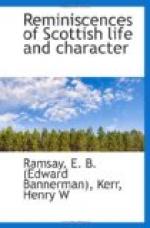I quite agree with Mr. Gillespie on the point, and think it not a good sign either of our religious belief or religious feeling that such blessings should become really a matter of reminiscence; for if we are taught to pray for one another, and if we are taught that the “prayer of the righteous availeth much,” surely we ought to bless one another, and surely the blessing of those who are venerable in the church from their position, their age, and their piety, may be expected to avail as an aid and incentive to piety in those who in God’s name are so blest. It has struck me that on a subject closely allied with religious feelings a great change has taken place in Scotland during a period of less than fifty years—I mean the attention paid to cemeteries as depositories of the mortal remains of those who have departed. In my early days I never recollect seeing any efforts made for the embellishment and adornment of our churchyards; if tolerably secured by fences, enough had been done. The English and Welsh practices of planting flowers, keeping the turf smooth and dressed over the graves of friends, were quite unknown. Indeed, I suspect such attention fifty years ago would have been thought by the sterner Presbyterians as somewhat savouring of superstition. The account given by Sir W. Scott, in “Guy Mannering,” of an Edinburgh burial-place, was universally applicable to Scottish sepulchres[20]. A very different state of matters has grown up within the last few years. Cemeteries and churchyards are now as carefully ornamented in Scotland as in England. Shrubs, flowers, smooth turf, and neatly-kept gravel walks, are a pleasing accompaniment to head-stones, crosses, and varied forms of monumental memorials, in freestone, marble, and granite. Nay, more than these, not unfrequently do we see an imitation of French sentiment, in wreaths of “everlasting” placed over graves as emblems of immortality; and in more than one of our Edinburgh cemeteries I have seen these enclosed in glass cases to preserve them from the effects of wind and rain.
In consequence of neglect, the unprotected state of churchyards was evident from the number of stories in circulation connected with the circumstance of timid and excited passengers going amongst the tombs of the village. The following, amongst others, has been communicated. The locale of the story is unknown, but it is told of a weaver who, after enjoying his potations, pursued his way home through the churchyard, his vision and walking somewhat impaired. As he proceeded he diverged from the path, and unexpectedly stumbled into a partially made grave. Stunned for a while, he lay in wonder at his descent, and after some time he got out, but he had not proceeded much farther when a similar calamity befell him. At this second fall, he was heard, in a tone of wonder and surprise, to utter the following exclamation, referring to what he considered the untenanted graves: “Ay! ir ye a’ up an’ awa?”




